Archived Commercial Blog Posts
How Do Fire Sprinklers Work During a Fire?
10/16/2022 (Permalink)
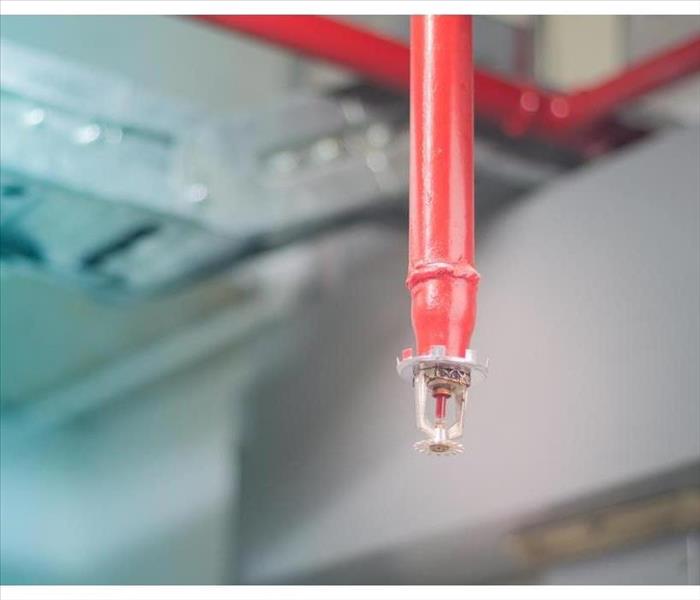 Sprinkler systems are composed of several different components, including the pipes, sprinkler heads and alarm valves.
Sprinkler systems are composed of several different components, including the pipes, sprinkler heads and alarm valves.
How Do Fire Sprinklers Operate in the Event of a Fire?
Sprinklers are an important part of any fire suppression system. They’re designed to suppress fires in the early stages, before they have a chance to spread and cause significant damage. Sprinkler systems are composed of several different components, including the pipes, sprinkler heads and alarm valves. When the heat of a fire reaches a certain level, it ignites the fire sprinkler head mounted on the ceiling or wall. This causes water to spray out in all directions and extinguish most small fires before they can become large ones.
Fire sprinklers are a vital part of preventing significant damage to commercial and industrial buildings.
The National Fire Protection Association (NFPA) requires that all new construction and major renovations comply with NFPA 13, Standard for the Installation of Sprinkler Systems. To prevent the spread of fire, sprinklers are required in certain areas of buildings based on their construction type and occupancy classification.
Sprinklers can save lives and property when they're properly installed and maintained. They're most effective when used in combination with other fire protection systems such as smoke alarms (smoke detectors), carbon monoxide alarms (CO detectors), automatic water mist extinguishers, standpipe systems, hose cabinets or deluge systems—or any combination thereof—to protect against multiple hazards in your building's specific type of occupancy.
Sprinklers are so effective and reliable that they’re required by the National Fire Protection Association to be installed in most commercial buildings. This is because sprinklers have been proven to reduce fire damage and end up saving businesses money over time.
Sprinkler systems are composed of several different components, including the pipes, sprinkler heads and alarm valves.
When someone pulls the fire alarm in an office or hotel, it activates a valve that opens water to all the sprinkler heads in that area. The water flowing from these sprinklers can range anywhere between 30-50 gallons per minute. This keeps an area free from smoke and flames until firefighters arrive on scene.
When the heat of a fire reaches a certain level, it ignites the fire sprinkler head mounted on the ceiling or wall.
A fire sprinkler system is made up of several parts. The most important part is the fire sprinkler head, which is mounted on the ceiling or wall.
When a fire occurs, it heats up until it reaches a certain temperature, at which point the sprinkler head opens and releases water onto the flames. This causes them to extinguish before they can spread throughout your home or business.
Sprinklers are an important way to make sure your building is protected from fire. They’re easy to install, maintain and operate, so you can rest assured that this system will work when it counts most.
What To Do When a Pipe Bursts
5/27/2022 (Permalink)
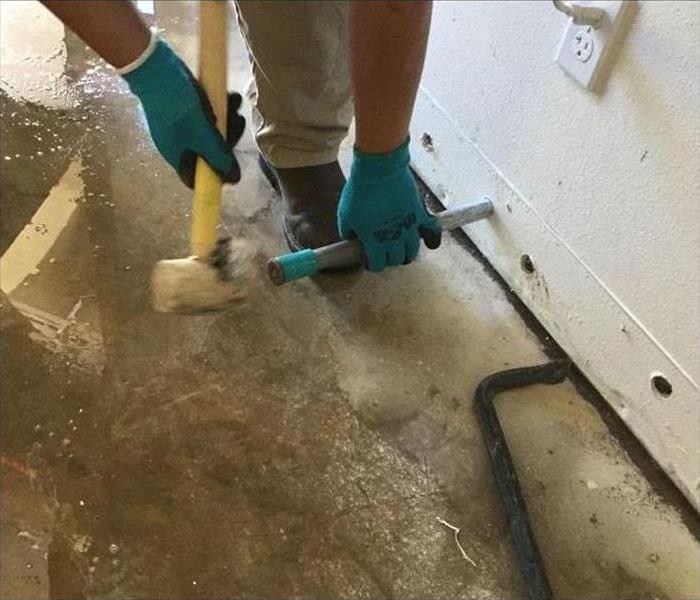 Water restoration after a pipe break in Bunker Hill Village, TX.
Water restoration after a pipe break in Bunker Hill Village, TX.
When a Pipe Bursts, What Do You Do?
Bursting pipes aren't always located out in the open; sometimes, they are situated behind the walls where they are out of sight and hard to recognize. Within minutes, your commercial property could experience a lot of damage because of a broken or leaking pipe behind the walls. Sadly, broken pipes are some of the most common causes of water damage in Bunker Hill Village, TX, and in many of these cases, a burst or leaking pipe could go unnoticed until serious damage has occurred.
Take Quick Action
As soon as you notice that your property has suffered water damage, you should take some quick steps to prevent further damage:
- Turn off the water at the water main.
- Open one or more faucets to decrease the water pressure in the pipes.
- Remove water as quickly and thoroughly as you can.
- Contact professionals to fix the broken pipe and provide further cleanup and repair services.
Your quick actions could mean the difference between containing the damage and experiencing extensive, widespread trouble.
Recognize the Potential for Trouble
There are many pipes throughout your property that could cause a lot of damage. Bursting pipes often happen when plumbing and other systems are installed along the exterior of the home without enough insulation to protect them from freezing. Aging pipes can develop leaks or cracks if they are exposed to pests or unusual amounts of water pressure. If the original installation of the pipes wasn't handled correctly, slow leaks could cause damage for a long time before you notice them.
Get Help Quickly
Once any damage has happened, it's important to contact water damage cleanup and repair professionals to correct the situation. In addition to putting your business back into a safe working condition, the technicians may also help you recognize other areas of weakness and concern. It's definitely better to avoid damage altogether when it's possible to take preventative action.
You may not always recognize water damage when it first occurs, but when you do notice the damage, take quick action. It doesn't take long for bursting pipes and running water to cause a lot of harm.
Understanding the Mold Remediation Process
5/22/2022 (Permalink)
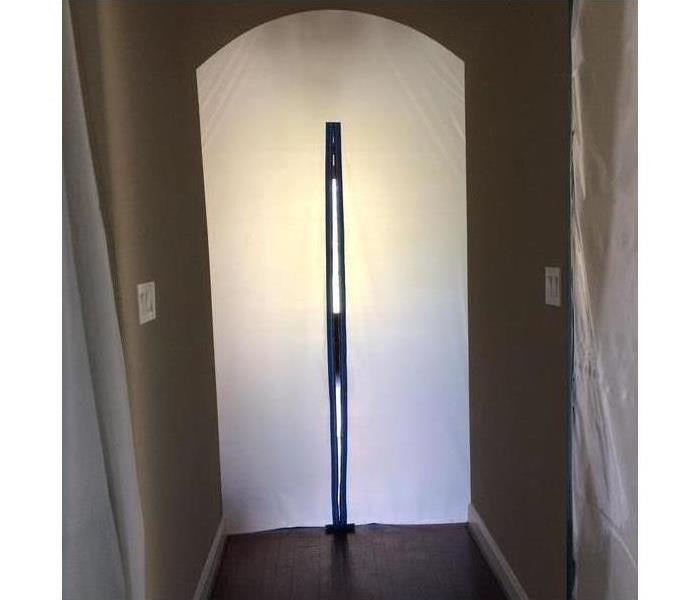 Mold containment procedures.
Mold containment procedures.
Steps For Removing Mold From Your Building
If you suspect you have black mold in your building in Hilshire Village, TX, the best thing you can do to protect your business is remove it. Unfortunately, getting rid of the fungus is not as simple as spraying bleach on it and hoping it goes away. In fact, bleach and other household cleaners are not well-suited to do the job. Mold removal is an involved process that needs serious consideration.
Here are four steps for removing mold from your building.
1. Call for Help
It is always recommended to enlist the help of professionals and avoid attempting the mold cleanup process on your own. Professional mold removal services will ensure the job is done properly, eliminating the chance of the fungus growing back and haunting you with future damage.
2. Contain the Mold
To keep it from spreading, block off the contaminated area by setting up physical barriers and sealing off doors and windows. In addition to containment, you should cut off any airflow to the affected area.
3. Remove the Mold
The method of removal largely depends on the surface the black mold is growing on and the size of the growth. Mold-infested items should be discarded, and infected areas should be treated with antimicrobial and antifungal solutions.
4. Disinfect the Area
Once the fungus is removed, disinfect and sanitize the affected area. This process will prevent the infestation from returning and will help remove any odors that developed.
After the area has been thoroughly cleaned and disinfected, you can begin the mold remediation process to return your business to its pre-mold condition. Depending on the amount of damage, the restoration process may only require minor repairs, such as painting walls or replacing furniture and carpet, or it may be severe enough to require reconstruction of various parts of the building.
When it comes to removing black mold, you should not waste any time. Removing the fungus quickly and preventing the spread can help you avoid costly repairs. With swift action and thorough remediation, you can recover and get back in business in no time.
Why Routine Plumbing Maintenance Is Vital for Your Business
4/18/2022 (Permalink)
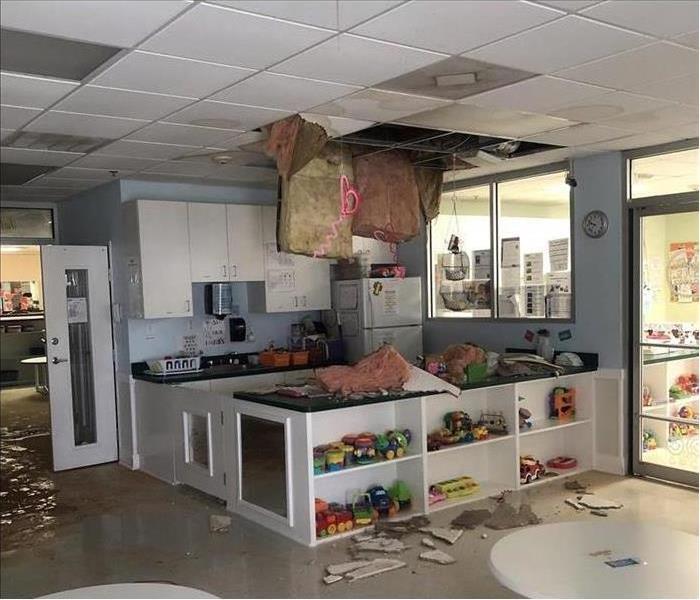 Commercial water damage in Bunker Hill Village, TX.
Commercial water damage in Bunker Hill Village, TX.
If you own a commercial office building in Bunker Hill Village, TX, routine plumbing maintenance can prevent costly repairs due to damaged pipes. Leaking pipes may lead to significant flooding, but other plumbing issues can also cause problems.
What Causes Pipe Damage?
Factors that compromise your building's plumbing system can include:
- Advanced age
- Poor insulation
- Clogged lines
- Unaddressed corrosion
Although some pipe deterioration and occasional backups are inevitable, many pipe damage consequences are avoidable by scheduling plumbing inspections that can reveal potential vulnerabilities.
How Can Inspections Save Money?
Discovering leaks as soon as possible after they begin can reduce the potential for significant damage and increase the chances that your business insurance policy will cover any losses. Leaking pipes can ruin carpets and upholstery, electronics and office supplies or walls and ceilings. Flooding from damaged pipes can also make surfaces susceptible to mold growth that costly remediation efforts must contain.
Insurance providers will likely not cover losses if pipe damage is due to inadequate maintenance, though they may cover flood damages from burst pipes. Still, contacting a flood restoration service to extract excess water as soon as possible after a flood is critical for reducing your business's monetary losses.
What Signs Indicate Leaks and Other Damage?
In addition to scheduling periodic plumbing inspections and repairs, it is helpful to know the signs that may indicate plumbing problems. Wet spots or stains on drywall, floor or ceilings could mean a long-term slow pipe leak. Loud banging or hissing sounds when water is running can occur when pipes are loose or unstable. Unpleasant odors may be due to clogs in the sewer line that can ultimately strain your plumbing with excess force and cause pipes to break. If tangible signs of pipe damage do not exist, a higher than typical water bill could indicate that you have cracked or leaking pipes.
Damaged pipes causing floods can be a headache for building owners in Bunker Hill Village, TX, but a flood restoration service can help clean up.
Why Mold Growth Should Be Taken Seriously by Building Owners
4/4/2022 (Permalink)
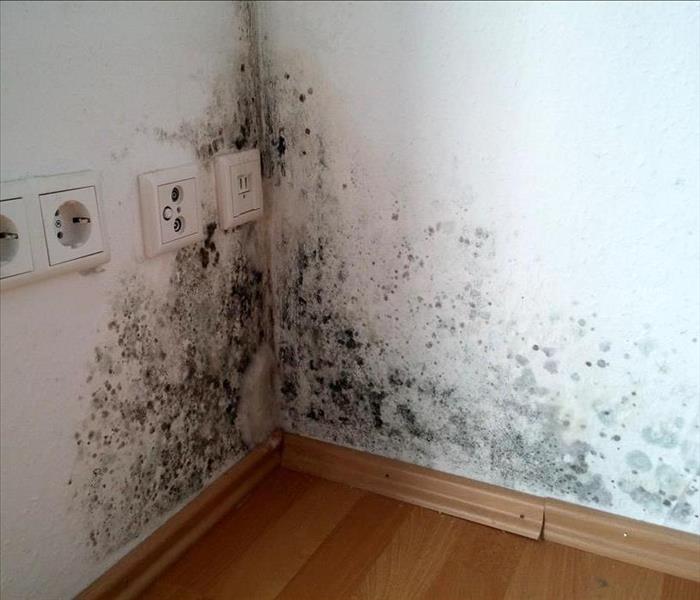 Mold damage in a property.
Mold damage in a property.
Ways To Prevent and Treat a Mold Break
When you lease or rent building space to clients, you have a number of responsibilities to maintain the property according to community standards. If you fail to do this, you could leave your company open to lawsuits. Mold insurance claims cover both property damages as the result of mold growth as well as certain liability issues. The presence of mold in your building could cause harm to your clients or tenants in a variety of ways:
- A business disruption
- A safety issue
- The destruction of personal items
- A health concern
Any of these problems could lead to a mold claim against your company. Fortunately, there are effective ways to prevent and treat a mold outbreak.
Mold Prevention
As with most problems, it is always better to avoid the issue than to have to clean it up. Understanding how mold grows is the key to preventing its appearance. Excess moisture is the primary cause of a fungal outbreak. An outbreak often happens after a leak that brings water into a building is not cleaned up in a professional manner. This enables mold that is present in a building to grow into colonies that harm materials and even degrade air quality. Many mold insurance claims come about because of a water leak.
Mold Remediation
A professional mold mitigation franchise such as SERVPRO is always Here to Help. If your building has a serious mold problem, highly-trained technicians perform an assessment and inspection that quickly identifies the extent of the problem. They will use equipment such as containment barriers, HEPA vacuums and air scrubbers to get the fungus under control. They will remove mold and mold-infested materials, clean contents and belongings and restore or replace any damaged items. A professional cleanup and restoration go a long way toward minimizing any mold insurance claims. Your clients or tenants can feel confident that the problem is taken care of once and for all.
Important Tips To Know Before Using a Fire Extinguisher
1/25/2022 (Permalink)
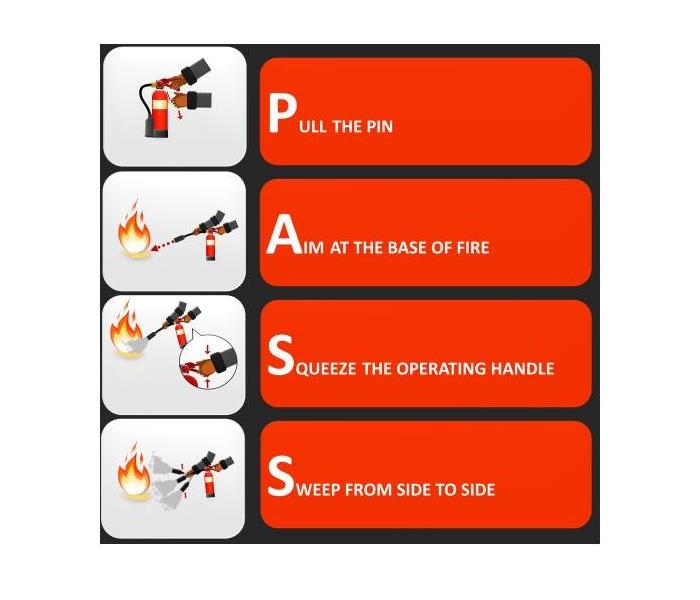 Initiate the P.A.S.S. method.
Initiate the P.A.S.S. method.
How To Properly Use a Fire Extinguisher
Determining how best to handle a kitchen fire in a commercial building is vastly important anywhere, but it is crucial in a place as busy as Bunker Hill Village, TX. After all, trying to make such quick decisions in the heat of the moment can be difficult for some and nearly impossible for others. Learning even a couple of essential tips for how to properly use a fire extinguisher can make all the difference, whether it is for something as simple as minimizing fire damage or as important as saving lives.
No one wants to face a fire, but accidents can happen at any time. When you’re forced into a situation where using an extinguishing tool is necessary, utilize these helpful tips:
1. Choose the right type of extinguisher. Unbeknownst to many, there are actually different kinds of extinguishers for specific types of fires. In the event of a fire raging out of control due to cooking oils and/or grease, the best extinguishers to use are either the foam option (marked with a yellow band) or the carbon dioxide option (marked with a black band).
2. Initiate the P.A.S.S. method. To learn how to correctly use an extinguisher, many use this common acronym to remember the steps necessary to correctly activate it. The steps are as follows:
- Pulling out the pin at the top,
- Aiming the hose or nozzle at the direct source of the blaze,
- Squeezing the extinguisher’s handle to release the agent and
- Sweeping in a back and forth motion to fully hinder the flames.
In the event of a dangerous kitchen fire, staying calm and remembering these key tips for properly using a fire extinguisher can lessen the anxiety and panic that arises in the stress of the moment. Such helpful information can be important for preventing further fire damage, lowering restoration costs down the road that could quickly become a hefty fee.
 Sprinkler systems are composed of several different components, including the pipes, sprinkler heads and alarm valves.
Sprinkler systems are composed of several different components, including the pipes, sprinkler heads and alarm valves.





 24/7 Emergency Service
24/7 Emergency Service




